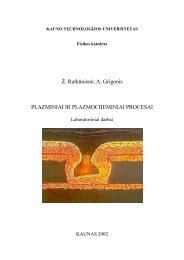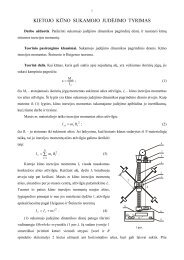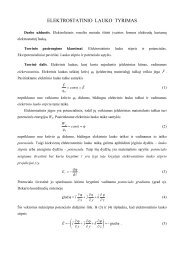PROCEEDINGS OF THE 7 INTERNATIONAL ... - Fizika
PROCEEDINGS OF THE 7 INTERNATIONAL ... - Fizika
PROCEEDINGS OF THE 7 INTERNATIONAL ... - Fizika
Create successful ePaper yourself
Turn your PDF publications into a flip-book with our unique Google optimized e-Paper software.
MEDICAL PHYSICS IN <strong>THE</strong> BALTIC STATES 7 (2009)<br />
Proceedings of International Conference “Medical Physics 2009”<br />
8 - 10 October 2009, Kaunas, Lithuania<br />
IGNALINA NUCLEAR POWER PLANT DOSE MONITORING<br />
SYSTEM<br />
*, Oleg Klepalov*, Kęstutis Gediminskas *, Romas VILKAS *, Mindaugas ZIKAS *, Gediminas ADLYS *<br />
* Kaunas University of Technology<br />
**Ignalina Nuclear Power Plant<br />
Abstract: The occupational exposure control is one of the important problem ensuring safety of personnel during<br />
operation of nuclear power plant.<br />
The TLD-system RADOS was set into operation in December of 1994. The software of this system ensured data<br />
interface between new system and existing database of INPP and provided a multi-user mode of data access.<br />
As a next step for the upgrading of the personal dosimetry system and preventing the overexposure of personnel in<br />
NPP a new electronic dosimetry system using RAD-80 and RAD-51dosimeters was implemented in 1997. Moreover<br />
the dynamic exchange of personal exposure from the electronic dosimetry data allowed planning the dose budget more<br />
exactly during implementation of different kinds of activities (especially during maintenance period).<br />
Analysis and comparison of data obtained using both dosimetry systems has shown that in general the parallel<br />
application of the TLD-system and electronic dosimetry system allowed to improve the quality of dose reduction<br />
measures, which represented the effectiveness of the implementation of ALARA program in NPP.<br />
Keywords: personal dosimetry system, TLD, dose monitoring, ALARA<br />
1. Introduction<br />
The first unit of Ignalina NPP went into service at the<br />
end of 1983, the second unit was set into operation in<br />
1987. Their design lifetime was projected out to 2010 -<br />
2015. A total of four units were originally planned on<br />
this site.<br />
The Ignalina NPP contains two RBMK-1500 reactors.<br />
This is the most advanced version of the RBMK reactor<br />
design series. Compared to the Chernobyl NPP, the<br />
Ignalina NPP is more powerful (1500 MW versus 1000<br />
MW), and is provided with an improved ACS (Accident<br />
Confinement System).<br />
Data base of Ignalina NPP consists of data on about<br />
3500 persons, therefore the problem of duly and correct<br />
record-keeping of the personnel occupational exposure<br />
data and management of personal doses is one of the<br />
important problems ensuring safety of personnel during<br />
operation of the plant.<br />
During first years of the INPP operation film dosimeters<br />
of type IFKU were used for the monitoring of personnel<br />
occupational exposures. However the old system had<br />
several essential imperfections, such as:<br />
• low range of measurement (0.5 – 20 mSv);<br />
• special conditions for processing the<br />
dosimeters were required;<br />
• possibility to lose data if the film is spoilt<br />
by light or by heat;<br />
83<br />
• automatic registration and transmission of<br />
the data was not provided etc.<br />
It was clear that some measures to improve the existing<br />
personal dosimetry system have to be considered taking<br />
into account the growing strictness of requirements and<br />
international recommendations that occupational<br />
concerning personnel exposure.<br />
The first step for improving the personal dosimetry<br />
system at INPP was made in 1989. In this year INPP<br />
started to use new type of TL dosimeters with Al2O3<br />
detectors. These dosimeters had a number of advantages<br />
as compared to film dosimeters:<br />
• wider range of measurement (0.1-10 4 mSv);<br />
• stable sensitivity;<br />
• mechanical durability.<br />
Besides after modernization of the dosimeter processing<br />
unit the possibility to transfer data from the<br />
measurement unit to a computer was provided, that<br />
made the creation of the exposure database for NPP<br />
workers possible. However this system had some<br />
weaknesses too: very high photosensitivity of detectors,<br />
manual processing were the main problems using this<br />
system.<br />
To overcome the above mentioned problems the project<br />
for the developing and improvement of the personal<br />
dosimetry system in INPP was initiated in 1994 within<br />
the framework of the "Bilateral Technical Assistance<br />
Program between Sweden and Lithuania in order to<br />
enhance the radiation protection safety at Ignalina<br />
NPP".








